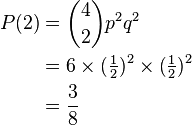Bernoulli trial
In the theory of probability and statistics, a Bernoulli trial (or binomial trial) is a random experiment with exactly two possible outcomes, "success" and "failure", in which the probability of success is the same every time the experiment is conducted.[1] The mathematical formalization of the Bernoulli trial is known as the Bernoulli process. This article offers an elementary introduction to the concept, whereas the article on the Bernoulli process offers a more advanced treatment.
Since a Bernoulli trial has only two possible outcomes, it can be framed as some "yes or no" question. For example:
- Did the coin land heads?
- Was the newborn child a girl?
Therefore, success and failure are merely labels for the two outcomes, and should not be construed literally. The term "success" in this sense consists in the result meeting specified conditions, not in any moral judgement. Examples of Bernoulli trials include:
- Flipping a coin. In this context, obverse ("heads") conventionally denotes success and reverse ("tails") denotes failure. A fair coin has the probability of success 0.5 by definition.
- Rolling a die, where a six is "success" and everything else a "failure".
- In conducting a political opinion poll, choosing a voter at random to ascertain whether that voter will vote "yes" in an upcoming referendum.
Definition
Independent repeated trials of an experiment with exactly two possible outcomes are called Bernoulli trials.
Call one of the outcomes "success" and the other outcome "failure".
Let  be the probability of success in a Bernoulli trial. Then the probability of failure
be the probability of success in a Bernoulli trial. Then the probability of failure  is given by
is given by
 .
.
Random variables describing Bernoulli trials are often encoded using the convention that 1 = "success", 0 = "failure".
Closely related to a Bernoulli trial is a binomial experiment, which consists of a fixed number  of statistically independent Bernoulli trials, each with a probability of success
of statistically independent Bernoulli trials, each with a probability of success  , and counts the number of successes. A random variable corresponding to a binomial is denoted by
, and counts the number of successes. A random variable corresponding to a binomial is denoted by  , and is said to have a binomial distribution.
The probability of exactly
, and is said to have a binomial distribution.
The probability of exactly  successes in the experiment
successes in the experiment  is given by:
is given by:
- Where
 is a Binomial coefficient
is a Binomial coefficient
Bernoulli trials may also lead to negative binomial distributions (which count the number of successes in a series of repeated Bernoulli trials until a specified number of failures are seen), as well as various other distributions.
When multiple Bernoulli trials are performed, each with its probability of success, these are sometimes referred to as Poisson trials.[2]
Example: tossing coins
Consider the simple experiment where a fair coin is tossed four times. Find the probability that exactly two of the tosses result in heads.
Solution
For this experiment, let a heads be defined as a success and a tails as a failure. Because the coin is assumed to be fair, the probability of success is  . Thus the probability of failure,
. Thus the probability of failure,  , is given by
, is given by
 .
.
Using the equation above, the probability of exactly two tosses out of four total tosses resulting in a heads is given by:
 .
.
See also
- Bernoulli scheme
- Bernoulli sampling
- Bernoulli distribution
- Binomial distribution
- Binomial coefficient
- Binomial proportion confidence interval
- Poisson sampling
- Sampling design
- Coin flipping
- Jacob Bernoulli
References
- ↑ Papoulis, A. (1984). "Bernoulli Trials". Probability, Random Variables, and Stochastic Processes (2nd ed.). New York: McGraw-Hill. pp. 57–63.
- ↑ Rajeev Motwani and P. Raghavan. Randomized Algorithms. Cambridge University Press, New York (NY), 1995, p.67-68
External links
| Wikimedia Commons has media related to Bernoulli trial. |
- Hazewinkel, Michiel, ed. (2001), "Bernoulli trials", Encyclopedia of Mathematics, Springer, ISBN 978-1-55608-010-4
- "Simulation of n Bernoulli trials". math.uah.edu. Retrieved 2014-01-21.
